 |
 |
|
Concerns Grow Over Safety Of Wood Recycling Plants Health and safety concerns around the recycling of waste wood products are once again in the news within the North West, with recent reports in local media of campaign groups focusing on local plants such as Sonae UK Ltd, in Kirkby and a plant run by R Plevin & Sons in the Mossley area of Manchester.
Ms Brockovich rose to fame in the 1990s after she discovered that health problems in a California community were being caused by toxins in the water supply. With the recent pulling of a report on the Mossley Environment Action Group’s campaign in the BBC TV magazine programme, ‘The One Show’, due to have been broadcast 22nd August, campaigners are beginning to smell a rat! Interestingly on 31st August, R Plevin & Sons were quoted in the Oldham Evening Chronicle, as saying: “We are certain our site is not the source of these alleged health problems. Nevertheless, as a responsible neighbour that has been operating in this community since 1995, we are happy to take part in additional tests, which are to be carried out by the Environment Agency in the autumn. We are confident the results will exonerate us.” Are these two occurances linked? Well, people can draw their own conclusions. Whilst most companies within the industry take their environmental pollution and health & safety responsibilities very seriously, and work hard to comply with local regulations; tragically for their employees and the wider local communities, there are those that not only treat such responsibilities with contempt, but also take severe action to silence their critics.
But just what are the problems with wood recycling processes? Dioxins and Mercury, plus Formaldehyde are the common ones which give rise to concerns for human health. One of the major sources of exposure is from inhalation of formaldehyde emitted from composite wood products containing urea-formaldehyde resins. In the USA, The International Agency for Research on Cancer (IARC) reclassified formaldehyde from "probably carcinogenic to humans" to "carcinogenic to humans" in 2004, based on the increased risk of nasopharyngeal cancer. Formaldehyde was also designated as a toxic air contaminant (TAC) in California in 1992 with no safe level of exposure. On July 2010, President Obama signed into law Senate Bill 1660, which established the Formaldehyde Standards for Composite Wood Products Act.
Commenting on the pollution risk, one expert in the field, who wishes to remain anonymous, told Unionsafety: “The real problems arise with the particle size distribution, particularly the smaller size ranges. Basically you have a respirable and inhalable particle size range. The respirable size range is less than 10 um (microns) and these particles easily lodge in passages and airways in the lung. The respirable dust fraction can be taken in the body via the mouth, nose and skin but generally end up in the stomach and are excreted. The expert continued: “In terms of biological attack, mercury is as we all know, is very bad news either as a fraction of dust that you inhale or whether it deposits directly onto the food chain. Dioxins are also problematic but they are ubiquitous in the environment and can be found in breast milk, air, food and water. The answers you need here is to find out which dioxins are being emitted from this plant and what the concentrations are. If this plant has large chimneys to purge their pollutants, well, it becomes a whole new ball game because then you have another/other emission source(s) to contend with.” In the UK, one of the leading companies within the industry is a Portuguese owned company called Sonae UK Ltd. Whilst their website states that they conform to all environmental and health and safety at work regulations, the history of the plant in Kirkby, Merseyside, tells another story.
Concerns regarding emissions to air, land and the local water table and supply are such that strict conditions are placed upon any wood recycling factory’s permit to operate within any local authority’s boundaries. Emissions to air19. All emissions to air, other than steam or condensed water vapour shall be:
20. a. The operator shall prevent or where that is not practicable reduce odour from the permitted installation. All emissions to air shall be free from offensive odour outside the site boundary as perceived by an officer of the Council. b. Operations shall be controlled with the aim of preventing fugitive visible emissions of particulate matter. 21. Emissions during normal operations shall be free from visible smoke and shall not exceed the equivalent of Ringelmann Shade 1 as described in British Standard BS 2742:1969. Despite this, numerous incidents air pollution have been reported by residents in the area, as a result of both the processes used in the factory, but also as a result of fire. Polluted air emanating from the chimney stacks of the factory are being blamed by local residents for causing a foul smell and respiratory problems. Further, the plant has been issued with four improvement notices by the HSE! “Dioxins are a very complicated set of environmental contaminants with major sources being steelworks and funnily enough Local Authority municipal incinerators, basically any process that uses fire in its process. Mercury attacks lots of biological systems i.e. the immune, nervous and reproductive system which is why the dark t-shirts use this extremely toxic heavy metal in vaccines and amalgam.”
It then lists a number of incidents involving pollution and safety at the plant. But the final entry, if completely accurate, may be a found to be a perfect example of a company acting with gross negligence with regard to the safety and health of its employees by the HSE investigating the incidents: "This latest incident at Sonae serves as yet another example of the fact that this plant is unstable and hazardous to local residents, businesses and those who work there. Sonae takes up far too much of the time and resources of the fire service, Knowsley Council and the Health and Safety Executive. I will shortly be calling a joint meeting of the various bodies responsible for monitoring Sonae to pool their experience and seriously consider whether it can be allowed to continue given the risks to the community." Despite the above record and calls for the factory to be closed down, not just by MPs, but also by leading health & safety campaigners, Professor Steve Tombs and Dr David Whyte based in Liverpool. Indeed in an attempt to report on the problems at the Sonae UK Ltd plant in Kirkby and have them investigated, legal pressures have been used by the company to try and silence those wishing to bring the company to justice. According to an article written by Steve Tombs and posted on the website of Merseyside cultural and local issues, Nerve Magazine (www.catalystmedia.org.uk), the company has tried to silence campaigners by threatening legal action on the basis that the company’s name was being discredited by such reports. This despite the fact that incidents of accidents, deaths, and possible local pollution, have been in the public domain for many years.
“Then, somewhat curiously, just before Christmas 2006, the hosts for our website informed Nerve that they’d received a letter from solicitors under Sonae’s instruction, threatening legal action against the website for having “a damaging effect on [Sonae’s] reputation”. But Sonae’s reputation is damaged not by what is written about it, but by its actions – it is a serial offender.” They concluded their comments by saying: “Sonae may well prefer the facts of its offending to be less rather than more public – that’s one of the intrinsic preferences of ‘power’. And in this, they fall into line with a long history of corporate efforts to silence critics, whether they are campaigners, journalists or academics. But as Helen Steele and Dave Morris, the ‘McLibel Two’, proved when they took on McDonalds, even against the biggest corporations, and even with inherently biased law, the truth can be spoken to power. Sonae’s bullying threats do not place us in any situation comparable to Morris and Steele’s heroic battle with McDonalds – except for the fact that this is also a fight that the corporate bullies cannot win.” It remains to be seen in the current climate with a Government attacking health and safety at work legislation as being ‘Red Tape’ and a major unnecessary cost to business, whether or not such plants as that of Sonae UK Ltd in Kirkby continue to be allowed to put profit before the lives of not only their own work force, but those of the local community which hosts their activities. Downloads: Knowsley Borough Council Sonae UK Ltd Draft Permit To Operate A Part ‘A2’ Installation University of South Wales Report On Composite Wood Products (Australia) See also: Sprucing Up Wood Waste - Biomass Magazine Local Campaign Against Sonae UK Knowsley Plant Takes To The Streets - Unionsafefy Sonae Kirkby factory discussed in parliament - They Work For You Source: Knowsley Metropolitan Borough Council / Wikipedia / Liverpool Echo / Sonae UK LTD / California Air Protection Agency / Hazards / The University of New South Wales / Catalyst Media, Nerve Magazine / Oldham Evening Chronicle
|
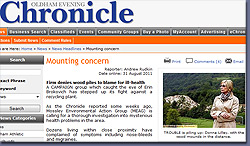
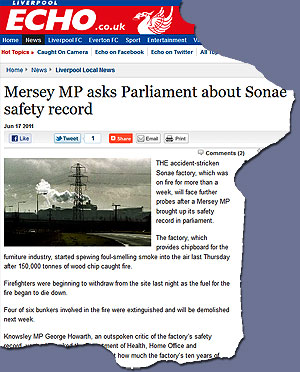
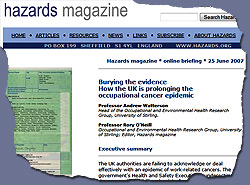
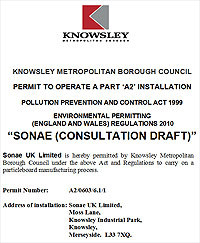
 But it is not just the processes used within the plant which are concerning both local residents and both Merseyside and Lancashire MPs.
But it is not just the processes used within the plant which are concerning both local residents and both Merseyside and Lancashire MPs.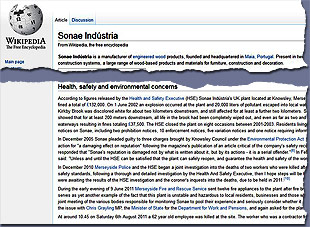

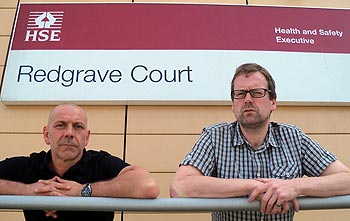 Writing in Spring of 2007 on the on-line magazine’s website and referring to an article written by them in 2004 which prompted such action by Sonae UK Ltd, Steve Tombs and David Whyte reported:
Writing in Spring of 2007 on the on-line magazine’s website and referring to an article written by them in 2004 which prompted such action by Sonae UK Ltd, Steve Tombs and David Whyte reported: